外研版高中英语必修四 Module1 Reading教案1-新版
- 格式:doc
- 大小:57.00 KB
- 文档页数:6
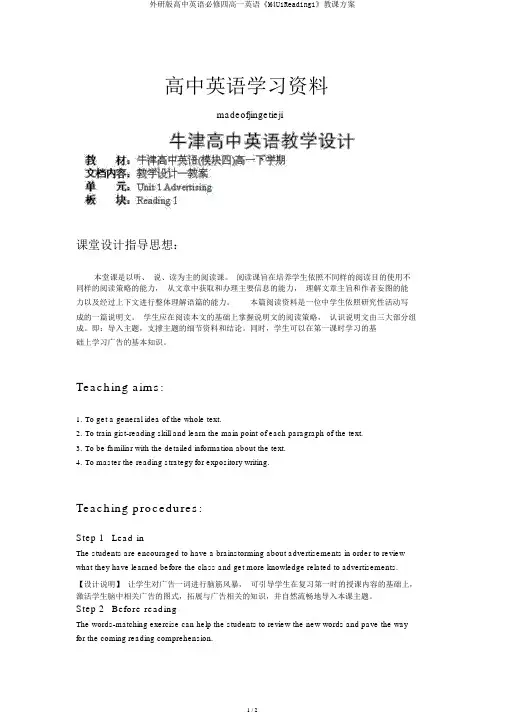
高中英语学习资料madeofjingetieji课堂设计指导思想:本堂课是以听、说、读为主的阅读课。
阅读课旨在培养学生依照不同样的阅读目的使用不同样的阅读策略的能力,从文章中获取和办理主要信息的能力,理解文章主旨和作者妄图的能力以及经过上下文进行整体理解语篇的能力。
本篇阅读资料是一位中学生依照研究性活动写成的一篇说明文。
学生应在阅读本文的基础上掌握说明文的阅读策略,认识说明文由三大部分组成。
即:导入主题,支撑主题的细节资料和结论。
同时,学生可以在第一课时学习的基础上学习广告的基本知识。
Teaching aims:1.To get a general idea of the whole text.2.To train gist-reading skill and learn the main point of each paragraph of the text.3.To be familiar with the detailed information about the text.4.To master the reading strategy for expository writing.Teaching procedures:Step 1Lead-inThe students are encouraged to have a brainstorming about advertisements in order to review what they have learned before the class and get more knowledge related to advertisements.【设计说明】让学生对广告一词进行脑筋风暴,可引导学生在复习第一时的授课内容的基础上,激活学生脑中相关广告的图式,拓展与广告相关的知识,并自然流畅地导入本课主题。
Step 2Before-readingThe words-matching exercise can help the students to review the new words and pave the way for the coming reading comprehension.【设计说明】经过简单的练习设置检测学生对新学词汇的理解, 为下一步的阅读理解铺设道路。
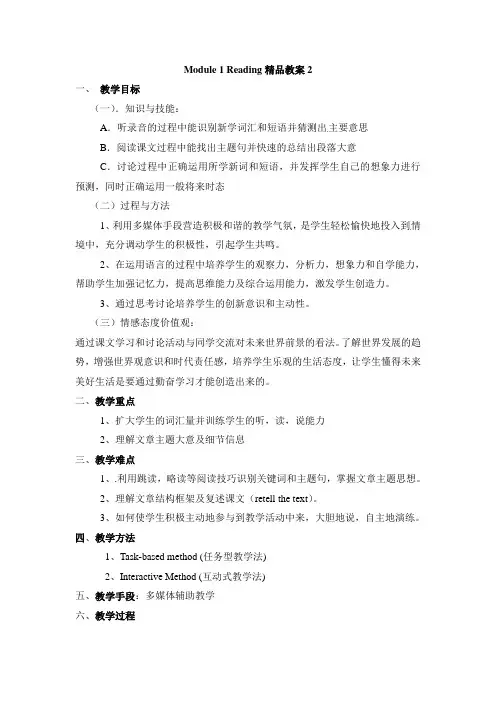
Module 1 Reading精品教案2
一、教学目标
(一).知识与技能:
A.听录音的过程中能识别新学词汇和短语并猜测出主要意思
B.阅读课文过程中能找出主题句并快速的总结出段落大意
C.讨论过程中正确运用所学新词和短语,并发挥学生自己的想象力进行预测,同时正确运用一般将来时态
(二)过程与方法
1、利用多媒体手段营造积极和谐的教学气氛,是学生轻松愉快地投入到情境中,充分调动学生的积极性,引起学生共鸣。
2、在运用语言的过程中培养学生的观察力,分析力,想象力和自学能力,帮助学生加强记忆力,提高思维能力及综合运用能力,激发学生创造力。
3、通过思考讨论培养学生的创新意识和主动性。
(三)情感态度价值观:
通过课文学习和讨论活动与同学交流对未来世界前景的看法。
了解世界发展的趋势,增强世界观意识和时代责任感,培养学生乐观的生活态度,让学生懂得未来美好生活是要通过勤奋学习才能创造出来的。
二、教学重点
1、扩大学生的词汇量并训练学生的听,读,说能力
2、理解文章主题大意及细节信息
三、教学难点
1、.利用跳读,略读等阅读技巧识别关键词和主题句,掌握文章主题思想。
2、理解文章结构框架及复述课文(retell the text)。
3、如何使学生积极主动地参与到教学活动中来,大胆地说,自主地演练。
四、教学方法
1、Task-based method (任务型教学法)
2、Interactive Method (互动式教学法)
五、教学手段:多媒体辅助教学
六、教学过程。
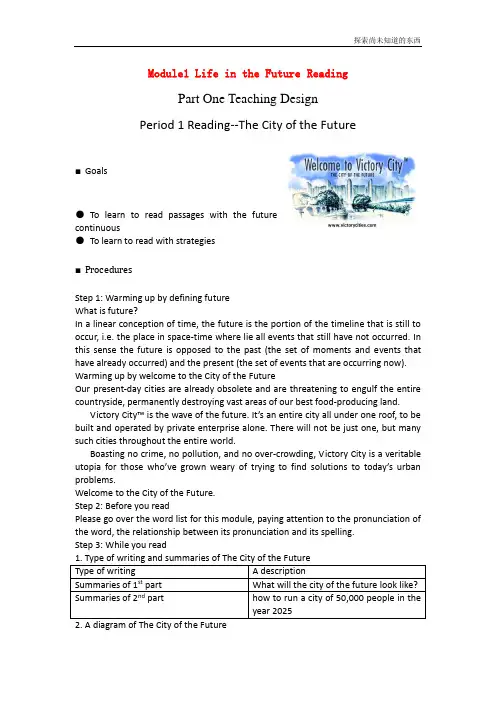
Module1 Life in the Future ReadingPart One Teaching DesignPeriod 1 Reading--The City of the Future■Goals●To learn to read passages with the futurecontinuous●To learn to read with strategies■ProceduresStep 1: Warming up by defining futureWhat is future?In a linear conception of time, the future is the portion of the timeline that is still to occur, i.e. the place in space-time where lie all events that still have not occurred. In this sense the future is opposed to the past (the set of moments and events that have already occurred) and the present (the set of events that are occurring now). Warming up by welcome to the City of the FutureOur present-day cities are already obsolete and are threatening to engulf the entire countryside, permanently destroying vast areas of our best food-producing land.Victory City™ is the wave of the future. It’s an entire city all under one roof, to be built and operated by private enterprise alone. There will not be just one, but many such cities throughout the entire world.Boasting no crime, no pollution, and no over-crowding, Victory City is a veritable utopia for those who’ve grown weary of trying to find solutions to today’s urban problems.Welcome to the City of the Future.Step 2: Before you readPlease go over the word list for this module, paying attention to the pronunciation of the word, the relationship between its pronunciation and its spelling.Step 3: While you readType of writing A descriptionSummaries of 1st part What will the city of the future look like? Summaries of 2nd part how to run a city of 50,000 people in theyear 20253. Complete the article with one word in each blankWhat will the city of the future be like? One __1__ is certain about the future city—they are going to get bigger before they get smaller. Here are __2__ of the ideas for running a city of 50,000 people in the year 2025. To get rid of garbage problems, __3__ city will load huge spaceships with waste materials and send them towards the sun, __4__ landfill/ and environmental problems. Nets Police will arrest criminals by firing nets __5__ of guns. No smoking will be allowed within a future city’s limit s. In the future all _6__will be done online, and catalogues will have voice commands to place orders. Everyone __7__ be given a telephone number at birth that will never change no matter where they live. All __8__of recreation, such as cinemas, bowling, softball, concerts and others, will be provided free __9__charge by the city. All cars will be powered by electricity, solar energy or wind. __10__surgery will become common. People will take their holidays at home. Travelling in __11__by1. Why will care for the environment become very important in the future?A. Because earth’s natural resources run outB. Because we will use lots of recycled materials, such as plastic, aluminium, steel, glass, wood and paper.C. Because we will waste fewer natural resources.D. Because we will also have to rely more on alternative energy.2. What does the word “landfill” mean in the text?A. an area of land where large amounts of waste material are buried under the earthB. the process of burying large amounts of waste materialC. waste material that will be buriedD. a piece of land in the valley3. Is the word “mall” _____?A. British EnglishB. American EnglishC. Australian EnglishD. African English4. What is not mentioned as an idea for running the future city?1. You are going to make your own sentences with the expressions form this module。
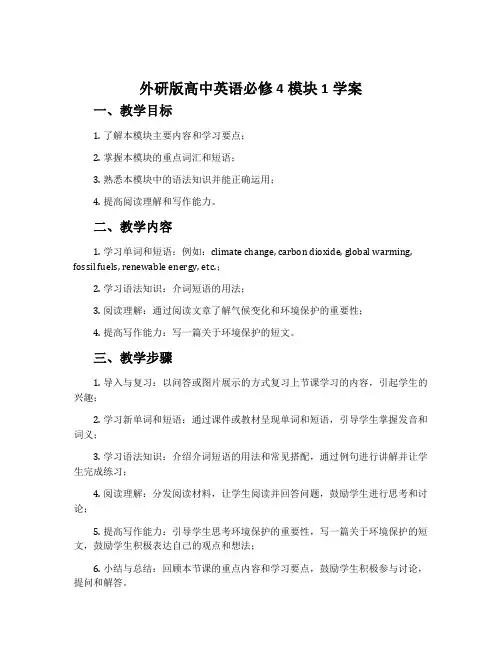
外研版高中英语必修4模块1学案一、教学目标1.了解本模块主要内容和学习要点;2.掌握本模块的重点词汇和短语;3.熟悉本模块中的语法知识并能正确运用;4.提高阅读理解和写作能力。
二、教学内容1.学习单词和短语:例如:climate change, carbon dioxide, global warming, fossil fuels, renewable energy, etc.;2.学习语法知识:介词短语的用法;3.阅读理解:通过阅读文章了解气候变化和环境保护的重要性;4.提高写作能力:写一篇关于环境保护的短文。
三、教学步骤1.导入与复习:以问答或图片展示的方式复习上节课学习的内容,引起学生的兴趣;2.学习新单词和短语:通过课件或教材呈现单词和短语,引导学生掌握发音和词义;3.学习语法知识:介绍介词短语的用法和常见搭配,通过例句进行讲解并让学生完成练习;4.阅读理解:分发阅读材料,让学生阅读并回答问题,鼓励学生进行思考和讨论;5.提高写作能力:引导学生思考环境保护的重要性,写一篇关于环境保护的短文,鼓励学生积极表达自己的观点和想法;6.小结与总结:回顾本节课的重点内容和学习要点,鼓励学生积极参与讨论,提问和解答。
四、教学方法1.演示法:通过课件、图片等辅助材料呈现新词汇和语法知识;2.合作学习:鼓励学生在小组内讨论,互相交流和帮助;3.创造性思维:引导学生进行发散思维,培养学生创造性思考和表达能力。
五、教学评价1.口头评价:教师通过提问和讨论的方式,检查学生对课堂内容的掌握情况;2.笔头评价:分发练习题或作文题,让学生进行书面评价。
六、教学资源1.教材:《外研版高中英语必修4》2.课件:包括单词和短语的呈现、语法知识的讲解、阅读材料的展示等;3.练习题和作文题。
以上是关于外研版高中英语必修4模块1学案的简要介绍,本学案的教学目标是帮助学生了解气候变化和环境保护的重要性,掌握相关的词汇和语法知识,并提高阅读和写作能力。
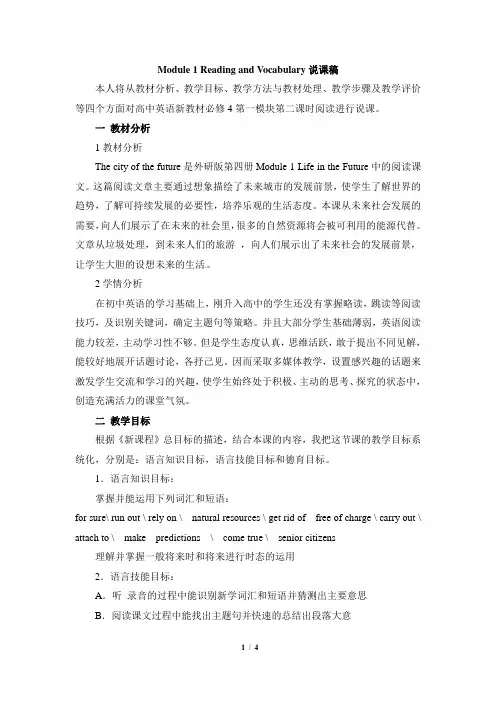
Module 1 Reading and Vocabulary说课稿本人将从教材分析、教学目标、教学方法与教材处理、教学步骤及教学评价等四个方面对高中英语新教材必修4第一模块第二课时阅读进行说课。
一教材分析1教材分析The city of the future是外研版第四册Module 1 Life in the Future中的阅读课文。
这篇阅读文章主要通过想象描绘了未来城市的发展前景,使学生了解世界的趋势,了解可持续发展的必要性,培养乐观的生活态度。
本课从未来社会发展的需要,向人们展示了在未来的社会里,很多的自然资源将会被可利用的能源代替。
文章从垃圾处理,到未来人们的旅游,向人们展示出了未来社会的发展前景,让学生大胆的设想未来的生活。
2学情分析在初中英语的学习基础上,刚升入高中的学生还没有掌握略读,跳读等阅读技巧,及识别关键词,确定主题句等策略。
并且大部分学生基础薄弱,英语阅读能力较差,主动学习性不够。
但是学生态度认真,思维活跃,敢于提出不同见解,能较好地展开话题讨论,各抒己见。
因而采取多媒体教学,设置感兴趣的话题来激发学生交流和学习的兴趣,使学生始终处于积极、主动的思考、探究的状态中,创造充满活力的课堂气氛。
二教学目标根据《新课程》总目标的描述,结合本课的内容,我把这节课的教学目标系统化,分别是:语言知识目标,语言技能目标和德育目标。
1.语言知识目标:掌握并能运用下列词汇和短语:for sure\ run out \ rely on \ natural resources \ get rid of free of charge \ carry out \ attach to \ make predictions \ come true \ senior citizens理解并掌握一般将来时和将来进行时态的运用2.语言技能目标:A.听录音的过程中能识别新学词汇和短语并猜测出主要意思B.阅读课文过程中能找出主题句并快速的总结出段落大意C.讨论过程中正确运用所学新词和短语,并发挥学生自己的想象力进行预测,同时正确运用一般将来时态。
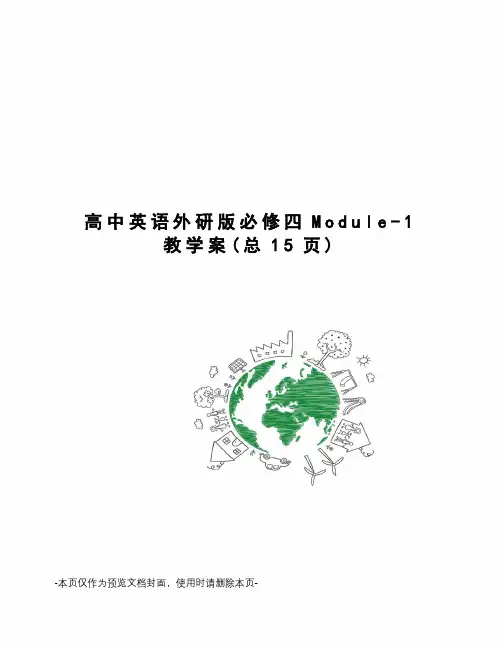
高中英语外研版必修四M o d u l e-1教学案(总15页)-本页仅作为预览文档封面,使用时请删除本页-必修四Module 1 Life in the FuturePart I Reading and VocabularyTeaching aims: (1) 阅读学习课文The City of the Future,能在阅读中识别新学词汇、短语并推断出其意义;能读懂课文,获取主要信息并能摘录要点。
(2) 了解想象中的未来的生活或城市,了解可持续发展的必要性。
(3) 学习掌握课文中的知识点。
Important language points:(1) Important words:prediction, certain, alternative, limit, attach(2) Important phrases:for sure, care for, run out, rely on/ upon, get rid of, load….with…, place orders,free of charge, carry out(3) Important sentence patterns:① What does… look like?②Everyone will be given a telephone number at birth that will never change no matter where they live.③---with each city having its own telesurgery outpatient clinic独立主格结构.The City of the Future【课文理解】1. Read the passage and say if these statements are true (T) or false (F).1) Police will arrest criminals by guns. ( )2) Smoking will be allowed in the city. ( )3) People have to pay for recreation. ( )4) People will keep their telephone number for life. ( )2. Summary Fill in the blanks:What will the city of the future ________ ________ No one knows ________ _______. In the future, _______ ________ the environment will become very important ________ earth’s natural resou rces ________ ________. We will_________ _________ alternative energy. We will ________ huge spaceships________ waste materials and _________ _________ online.【课文学习】1. What will the city of the future look like?What does… look like 用于询问某人外表看起来如何,侧重其外表如:What does the building look like 这座楼看起来如何?这人看起来什么样 What does the man ______ ________2. No one knows for sure, and making predictions is a risky business.没有人确切地知道,而且预测是一件冒险的事。

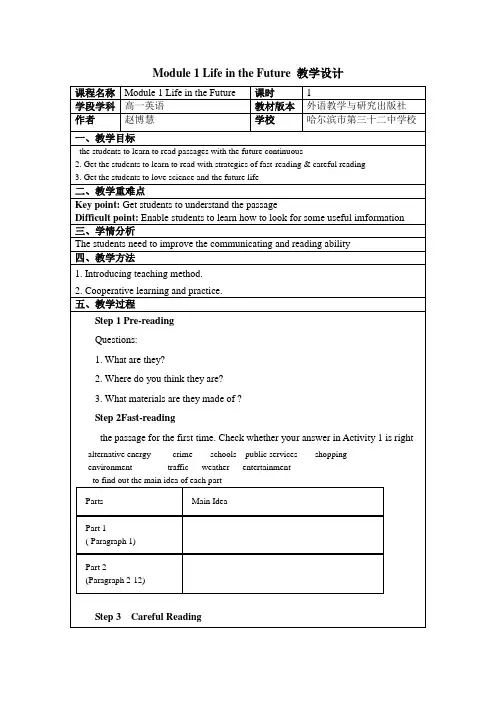
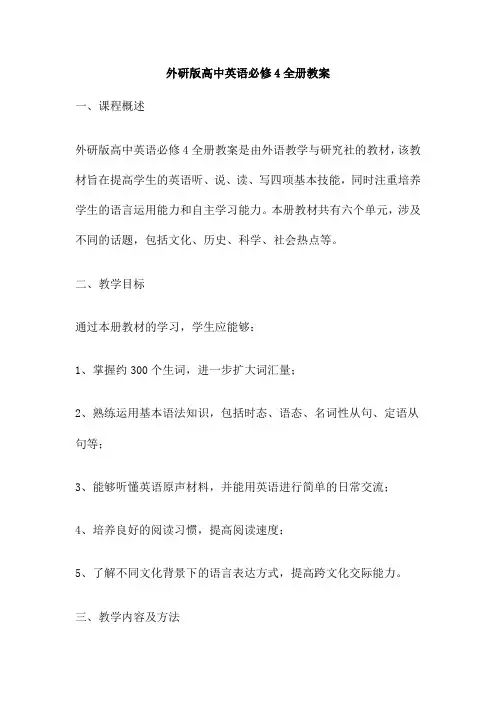
外研版高中英语必修4全册教案一、课程概述外研版高中英语必修4全册教案是由外语教学与研究社的教材,该教材旨在提高学生的英语听、说、读、写四项基本技能,同时注重培养学生的语言运用能力和自主学习能力。
本册教材共有六个单元,涉及不同的话题,包括文化、历史、科学、社会热点等。
二、教学目标通过本册教材的学习,学生应能够:1、掌握约300个生词,进一步扩大词汇量;2、熟练运用基本语法知识,包括时态、语态、名词性从句、定语从句等;3、能够听懂英语原声材料,并能用英语进行简单的日常交流;4、培养良好的阅读习惯,提高阅读速度;5、了解不同文化背景下的语言表达方式,提高跨文化交际能力。
三、教学内容及方法本册教材共有六个单元,每个单元都有一个主题,包括:1、Unit 1: The Great Sports Figures通过介绍几位体育明星,学习如何用英语表达自己的喜好和看法。
通过阅读和听力练习,培养学生的阅读能力和语言感知能力。
2、Unit 2: Factory Life in the 19th Century通过介绍19世纪工厂生活,让学生了解工业革命对人类社会的影响。
通过写作练习,让学生掌握如何描述一个时代的特点。
3、Unit 3: A Job Worth Doing通过介绍不同职业的特点和要求,让学生了解职业规划的重要性。
通过口语练习,让学生学会如何用英语介绍自己的职业规划。
4、Unit 4: Exploring the World of Science通过介绍科学领域的发展和成就,让学生了解科学技术的魅力。
通过阅读和听力练习,培养学生的科学素养和创新能力。
5、Unit 5: The Silver Screen通过介绍电影的历史和制作过程,让学生了解电影艺术的魅力。
通过口语练习,让学生学会如何用英语表达对电影的看法和感受。
6、Unit 6: The Universal Language of Music通过介绍不同音乐类型和特点,让学生了解音乐艺术的魅力。
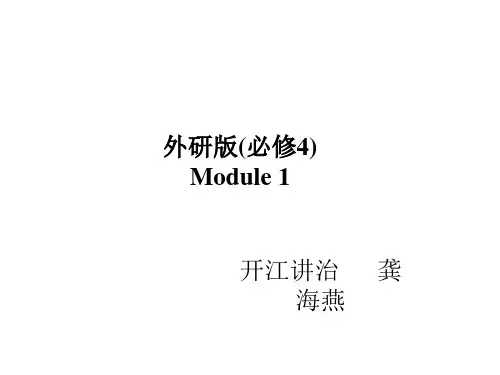
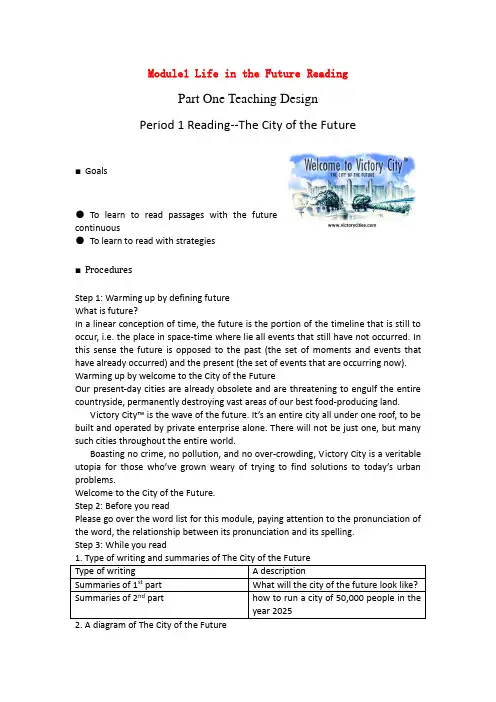
Module1 Life in the Future ReadingPart One Teaching DesignPeriod 1 Reading--The City of the Future■Goals●To learn to read passages with the futurecontinuous●To learn to read with strategies■ProceduresStep 1: Warming up by defining futureWhat is future?In a linear conception of time, the future is the portion of the timeline that is still to occur, i.e. the place in space-time where lie all events that still have not occurred. In this sense the future is opposed to the past (the set of moments and events that have already occurred) and the present (the set of events that are occurring now). Warming up by welcome to the City of the FutureOur present-day cities are already obsolete and are threatening to engulf the entire countryside, permanently destroying vast areas of our best food-producing land.Victory City™ is the wave of the future. It’s an entire city all under one roof, to be built and operated by private enterprise alone. There will not be just one, but many such cities throughout the entire world.Boasting no crime, no pollution, and no over-crowding, Victory City is a veritable utopia for those who’ve grown weary of trying to find solutions to today’s urban problems.Welcome to the City of the Future.Step 2: Before you readPlease go over the word list for this module, paying attention to the pronunciation of the word, the relationship between its pronunciation and its spelling.Step 3: While you readType of writing A descriptionSummaries of 1st part What will the city of the future look like? Summaries of 2nd part how to run a city of 50,000 people in theyear 20253. Complete the article with one word in each blankWhat will the city of the future be like? One __1__ is certain about the future city—they are going to get bigger before they get smaller. Here are __2__ of the ideas for running a city of 50,000 people in the year 2025. To get rid of garbage problems, __3__ city will load huge spaceships with waste materials and send them towards the sun, __4__ landfill/ and environmental problems. Nets Police will arrest criminals by firing nets __5__ of guns. No smoking will be allowed within a future city’s limit s. In the future all _6__will be done online, and catalogues will have voice commands to place orders. Everyone __7__ be given a telephone number at birth that will never change no matter where they live. All __8__of recreation, such as cinemas, bowling, softball, concerts and others, will be provided free __9__charge by the city. All cars will be powered by electricity, solar energy or wind. __10__surgery will become common. People will take their holidays at home. Travelling in __11__by1. Why will care for the environment become very important in the future?A. Because earth’s natural resources run outB. Because we will use lots of recycled materials, such as plastic, aluminium, steel, glass, wood and paper.C. Because we will waste fewer natural resources.D. Because we will also have to rely more on alternative energy.2. What does the word “landfill” mean in the text?A. an area of land where large amounts of waste material are buried under the earthB. the process of burying large amounts of waste materialC. waste material that will be buriedD. a piece of land in the valley3. Is the word “mall” _____?A. British EnglishB. American EnglishC. Australian EnglishD. African English4. What is not mentioned as an idea for running the future city?1. You are going to make your own sentences with the expressions form this module。
Book4Module1 Language Points 一、教学目标、方法和手段概述二、教学流程设计三、课时作业1. Remember the words , and recite the sentences.2. Finish the related exercises (附与模块相关的练习,见下面)附:Module1 反馈练习单词短语:1. 替换的,供选择的2. 逮捕,拘留3. 费用,价钱4. 命令,指令5.开火,启动6. 开关,交换,调换7.造成……形状8. 最后,终于9. 预测v.10.范围11. 依赖,依靠12. 装,装载13. 危险的,冒险的14. 失去能力,伤残15. 系,贴,连接16. 乐观的17. 无疑地,确定地18.肯定地19. 一出生20. 依靠21. 除掉;处理掉22. 免费23. 管理一个城市24. 装载25. 做手术26. 轻轻一按开关27. 绑在……上28.用完完成句子:1. No one knows (肯定地), and(做预测)is a risky business.2. In the future, care for the environment will become very important as earth’s natural resources (用完了).3. We will also have to (更多地依赖)alternative energy.4. (为了摆脱)garbage problems, the city will load huge spaceships waste materials.5. No smoking will be allowed . (在未来的城市内)6. Everyone will be given a telephone number (出生时)that will never change (无论他们生活在什么地方).7. All forms of recreation will be provided (免费) by the city.8. It will be possible to change the color of cars . (轻轻一按开关)选择:1. ______ garbage problems, the city will load huge spaceships with waste materials and send them towards the sun, ______ landfill and environmental problems.A. To get rid of; to preventB. Getting rid of; to preventC. To get rid of; preventingD. Getting rid of; preventing2. ______ will be possible to change the colour of cars at the flick of a switch.A. ThisB. WhatC. ThatD. It3. Senior citizens and people with disabilities will be able to go anywhere in the world using high-tech cameras ______ to their head.A. adjustedB. attachedC. adjustingD. attaching4. Football fans often make a about which team will win the coming match.A. professionB. preparationC. predictionD. progress5. We should think of a way to ______ people’s fear about natural disasters.A. get rid ofB. get along withC. run away fromD. come up with6.______ enters the computer rooms should take off his shoes in order to keep them clean enough.A. WhoB. WhoeverC. WhatD. Whatever四、课时评价设计1. 自我评价:说说学习过程中自己特别感兴趣并有帮助的三项活动,说出这些活动在哪些方五、教后记期中模块考试,大家的成绩虽然不是太理想,但是结束后的现在,大家学习的情绪却异常的高涨起来,这是一件令人兴奋地事情,单词的记忆,从默写的效果来看,还是令自己感到有些欣慰的。
Module 1 Reading教案1单元教学内容、目标要求
阅读训练课
(一)教学内容与学习目的
1话题内容:本节课的主题是阅读材料“The City of the Future”,阅读部分通过学生的想象描绘了未来城市的发展前景。
要求学生了解上述内容并
掌握有关的词汇,培养相关语言技能。
解决课本P1-P4内容。
2语言知识目标
掌握词汇:brick, concrete, mud, alternative, crime, prediction, risky, resource, material, rely, solar, urban, load, landfill, arrest, criminal, fire, limit, outdoors, online, catalogue, command, recreation, bowling, softball, charge, power, flick, switch, surgery, telesurgery, outpatient.
掌握短语:for sure, run out, rely on, get rid of, free of charge.
语言功能:谈论将来
话题:谈论未来生活
3语言技能目标
说:能复述课文内容,能正确运用一般将来时描述环境。
读:能在阅读中识别新学的词汇、短语并推断出其意义;能读懂课文,
获取主要信息并能摘录要点;能阅读和理解来自其他资源的相关文章。
表达与展示:向同学叙述自己所想像的未来生活或城市。
(二)学习策略
认知策略:归纳和整理已经学过的和新学习的与生活和环境有关的词汇,短语,类比记忆,并在阅读过程中尽可能多地使用。
调控策略:在阅读过程中不断地提取并加工有效信息,提高阅读效率。
交际策略:在阅读过程中,不断地与同学交往,正确理解对方话语的含义,并做出反应。
资源策略:在阅读课文前以及阅读课文后,通过学习活动与同学交流对未来世界其他方面的看法。
(三)文化意识
了解世界发展的趋势,了解可持续发展的必要,培养乐观的生活态度。
(四)任务
设计一所未来的房子,勾画盖房子的外景和内部设施,并向同学介绍。
(五)教学过程Teaching Procedures:
Step 1: Lead-in & Introduction (5 minutes)
Look at the picture and answer the questions.
Questions: What is it? Where do you think of it? Would you like to live in it?
●Ask the students to answer this question individually and then discuss
the answers with their partners.
●List the suggested answers on the board, and try to open up a discussion
with the topic.
Step 2: Brainstorming & Warming up (5 minutes)
●Ask the students the question: What building material can you think of?
Choose the building material to complete the sentences.
Ask the students to read through the words in the box, and have the students do the exercises in the form of a group competition.
1._____ is very light material
2._____ is very strong material.
3. Both ______ and ______ come from trees.
4. _____ is light, strong very popular and man-made.
5. _____ are often used to build walls.
6. _____ is very strong and is used in many modern buildings.
7. _____ is wet earth.
8. _____ is natural hard material.
9. _____ is used to make windows.
Step 3: Pre-reading – Discussion -- Pair work(5 minutes )
Work in pairs and 1) discuss what materials your school is made of/ from.
2) guess what materials the building in the picture is made of/ from.
Step 4: Pre-reading – Prediction – Class work (5 minutes)
Just read the titile and predict: Which of the following might be mentioned in the passage?
□alternative energy; □crime; □schools; □ public services □ shopping; □
environment; □traffic; □weather; □entertainment
Step 5: Fast-reading –Skimming and Scanning (3 minutes)
Read the passage within 3 minutes to get the topic mentioned.
Step 6: Detailed-reading – Individual Learning (7 minutes )
Read the passage carefully and answer the questions about the passage.
1.What have students in a Texas university done?
2.Where will garbage ships go?
3.Who will batman nets catch?
4.Where won't people be allowed to smoke?
5.How will people go shopping?
6.What number will people keep for life?
7.What won’t people have to pay for?
8.How will cars be different?
9.What will doctors do from a distance?
10.Where will old people go without moving?
Step 7: Survey – Group work ( 5 minutes)
Make a survey with the following questions in groups and try to report it to your classmates.
Which prediction in our passage …
1.is the strangest?
2.is the most useful?
3.will come true first?
4.will come true last?
Step 8: Project—Your ideal house in 2025 (7minutes)
Design an ideal house in the future and describe it to your classmates. If possible, draw it.
Step 9: Assessment (1 minute)
1.self-assessment: Can I understand the passage quite well? Can I communicate
with my classmates without any difficulty?
2.peers assessment: Who has the best design? Who performs the most
outstanding?
Step 10: Assignment – Writing (2 minutes)
You can choose either one:
1.Write a 5-sentence summary of the passage.
2.Write a 5-sentence description of your ideal house in 2025.
教学小结:本节课首先通过头脑风暴让学生熟悉建筑材料方面的词汇,联系起与房子有关的语言,然后由自己所在的学校房子的材料谈起,带着学生预测本文的主题,然后逐渐引入到本节课阅读文章的进行。
然后在快速阅读和细读文章,熟悉文章内容的基础上,开展调查,讨论设计房子等活动,让学生充分参与到本节课的主题讨论当中。
最后的评价及任务也进一步让学生自己学会评价本节课的表现并且学以致用,把读与写有机结合起来。